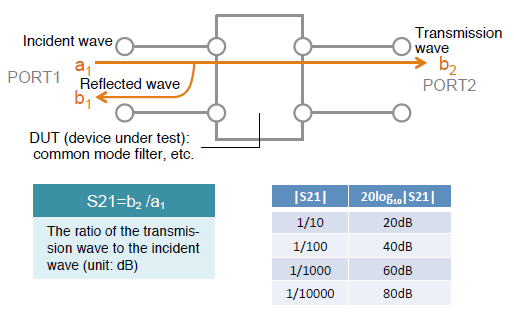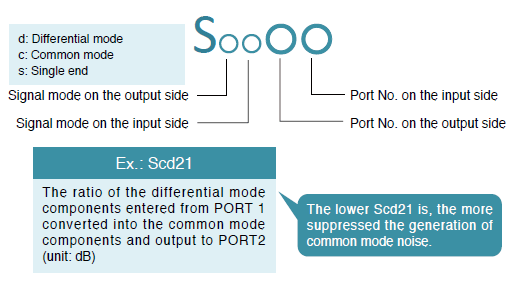World’s smallest level common-mode choke for automotive Ethernet

Ethernet forecast to be the backbone network for in-vehicle LANs
In-vehicle Ethernet networks are found in various parts of the automobile: body systems, safety systems, powertrain systems, and multimedia/information systems. Currently, CAN is the most common type of network, used mainly in body systems. It features a maximum data transfer speed of 1Mbps (5Mbps for CAN-FD). On the other hand, the maximum data transmission speed of FlexRay in powertrain systems is 10Mbps. However, these in-vehicle LANs have limitations in terms of data transmission speed and network expandability. By contrast, Ethernet features a higher data transmission speed of 100Mbps or faster, as well as superior expandability as a backbone network, enabling the user to implement an advanced network architecture. It is now attracting attention as an interface for developers who wish to realize IVI systems or ADAS.
The differential transmission system is generally adopted in in-vehicle LANs, except for LIN and low-speed CAN. The differential transmission system features low radiation noise and high immunity against external noise, and is adopted widely in high-speed interfaces that connect PCs with peripheral devices, such as USB or IEEE1394 interfaces. However, the cables of these high-speed interfaces function as antennas that radiate or pick up noise. For this reason, common mode filters are used at the connector parts of the interfaces as an EMC measure. Fig. 1 shows the applications of various in-vehicle LANs and the recommended TDK common mode filters that are used in these LANs.
Figure 1: Communication speed of each in-vehicle LAN and TDK's common mode filters used as an EMC measure
The use of Ethernet in-vehicle LANs that connect sensor-related or camera-related electronic devices for IVI systems or ADAS is becoming more widespread.
In-vehicle Ethernet standard from OPEN Alliance SIG
A common mode filter is an EMC countermeasure component that can effectively prevent only the common mode noise current, without affecting the differential mode signal current. However, the interior of an automobile is a noisy environment due to the strong magnetic fields induced in cables carrying large currents, inductive noise caused by motors, etc., and the instantaneous burst noise caused by the ignition plug. This has led to a requirement, therefore, for common mode filters for in-vehicle Ethernet with characteristics that are far better than those of existing products.
Figure 2: Roles of a common mode filter in in-vehicle Ethernet
An advantage of in-vehicle Ethernet is that inexpensive and lightweight UTP cables can be used; however, it is important to implement EMC measures against common mode noise.
Figure 3: Conceptual diagram of the S parameter (mixed mode) in a 2 terminal pair circuit
The characteristics requirements of common mode filters for in-vehicle Ethernet are standardized as "BroadR-Reach" by the OPEN Alliance SIG, a standards body. An in-vehicle Ethernet network may achieve high performance with a data transmission speed of 100Mbps through the differential transmission system when using UTP (unshielded twisted pair) cables. There is a big advantage for automobile manufacturers to the use of inexpensive and lightweight UTP cables, because they can significantly reduce the length and weight of the wire harness and contribute to reductions in both weight and fuel consumption.
Figure 4: Notation for the mode conversion characteristics
Mode conversion characteristics of a common mode filter for in-vehicle Ethernet
The S parameter is used as a measure of the noise characteristics or signal quality in in-vehicle Ethernet. The S parameter stands for the "scattering parameter," and expresses the circuit characteristics based on the degree of reflection or transmission of the wave when capturing alternating signals flowing through the circuit as waves. Fig. 3 is a conceptual diagram of the S parameter (mixed mode S parameter) in a 2 terminal pair circuit (4 terminal circuit). For the sake of simplicity, only transmission in the forward direction is explained. Incident wave a1 from PORT 1 is transmitted to port 2 as b2; however, part of it is reflected and returned to PORT 1. The ratio of transmission wave b2 to incident wave a1 at this point is expressed by parameter S21. This parameter is nearly equivalent to the insertion loss of filter characteristics, and is generally expressed in units of dB (decibels). The notation of 21 expresses the transmission from PORT 1 to PORT 2 (2 <- 1).
In common mode filters for in-vehicle Ethernet, the parameter called the mode conversion characteristic is important (Fig. 4). For example, the typical mode conversion characteristic Scd21 expresses the amount of mode conversion from the differential mode (d) components to the common mode (c) components in transmission from PORT 1 to PORT 2. To put it simply, the smaller Scd21 becomes, the smaller the proportion of the signal current (differential mode components) that is converted into the common mode component, thus suppressing the generation of common mode noise.
Easily satisfies the characteristics requirements of in-vehicle Ethernet
An example of the frequency characteristics of TDK's ACT45L type common mode filters for in-vehicle Ethernet is shown in Fig. 5. It is clear from Figure 5 that the common mode components are substantially blocked at around 10MHz to 100MHz (Scc21), whereas the differential mode components pass through with hardly any attenuation (Sdd21). Fig. 6 is a comparison of mode conversion characteristics between an existing product for CANs and the ACT45L type; the red solid line shows the characteristics requirements for in-vehicle Ethernet (Class A). When the characteristics curve is at the lower part of the graph, it shows that it is more difficult for signals (differential mode) to be converted into common mode noise, i.e. the product has a good characteristic as a common mode filter. The figure shows that, in the ACT45L type, the characteristic is improved approximately by 30dB in a wide frequency range compared to that of the existing product for CANs, and the series exceeds the strict characteristics requirements for in-vehicle Ethernet by a wide margin. Moreover, all the production processes for the ACT45L type are completely automated, which ensures the product offers consistently high quality and high reliability. The series also features a unique winding design and is produced with a high precision automatic winding system, which enables it to offer excellent mode conversion characteristics while maintaining a high inductance value of 200μH (at 100kHz) despite its small, low profile 4532 size.
Figure 5: Frequency characteristic example of ACT45L
Figure 6: Comparison of mode conversion characteristics between an existing product and the ACT45L type
Summary
Since Ethernet allows for high-speed transmission of large amounts of data, it has been adopted at a rapid pace in in-vehicle LANs, where it may be used to transmit high-quality video images through on-board cameras, etc., and to support safe and comfortable driving. TDK has developed the ACT45L type of common mode filters for in-vehicle Ethernet systems, taking advantage of the ferrite, winding and design technologies that it has developed over a long period of time. TDK will continue to enhance its line-up of miniature common mode filters for in-vehicle LANs, which includes the existing ACT45B/ACT45R types supporting the CAN standard and the ACT1210 type supporting the CAN and FlexRay standards.
Main features, applications and electrical characteristics of the ACT45L type
Main features
- Small and low profile (mounting area: 4.5 x 3.2mm, height: 2.8mm)
- Achieves an excellent mode conversion characteristic Scd21 while offering a high inductance value of 200μH, owing to TDK's unique winding technology and high precision automatic winding system
- Consistently ensures high quality and reliability thanks to wholly automated production processes
- Solderless design
- Conforms to AEC-Q200
- Conforms to RoHS directive and supports pb-free soldering
Main applications
- An EMC measure in in-vehicle Ethernet systems for communication of video images from on-board cameras, or audio signals
Main electrical characteristics
| Product name | Common mode inductance at 100kHz[μH]typ. |
DC resistance [Ω]max. |
Rated current [mA]max. |
Insulation resistance [MΩ]max. |
Rated voltage [v]max. |
|---|---|---|---|---|---|
| ACT45L-201-2P-TL000 | 200 | 4.5 | 100 | 10 | 50 |






